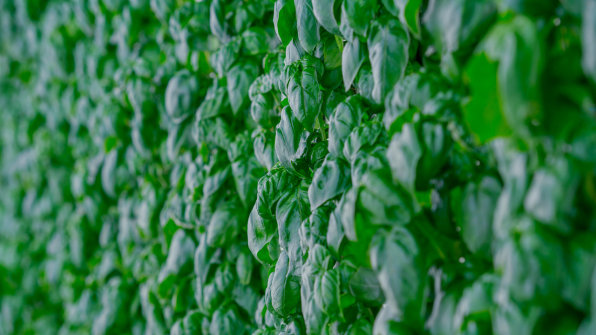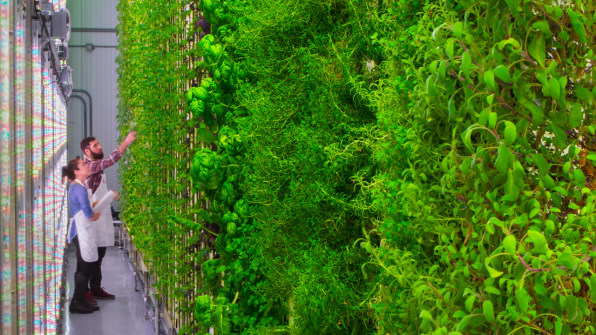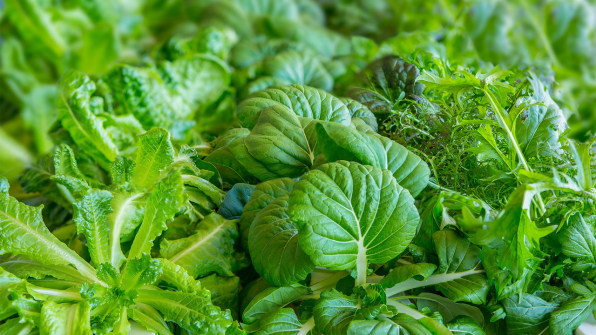Has This Silicon Valley Startup Finally Nailed The Indoor Farming Model?
“I like to call this the cathedral.” So says Matt Barnard, CEO and cofounder of the vertical farming startup Plenty. We’re standing in a room at the company’s headquarters in a former electronics distribution center in South San Francisco, staring up at glowing, 20-foot high towers filled with perfectly formed kale and herbs.
The company isn’t the first to build an indoor urban farm in a warehouse. Aerofarms, for example, grows greens in a 70,000-square foot former steel factory in Newark, New Jersey. Nearby, Bowery, another tech-filled indoor farm, grows what it calls “post-organic,” pesticide-free produce. But Plenty, which has received $26 million in funding to date from investors such as Bezos Expeditions and Innovation Endeavors, believes that it has the technology to grow food more efficiently–at the same cost or less than crops grown in the field–so it can more easily scale up to supply supermarkets around the world.
Inside another gleaming white room, wearing a food processing uniform and gloves, Barnard reaches up and picks rare varieties of basil, chives, a mustard green called mizuna, red leaf lettuce, sorrel, and Siberian kale, eating each and handing me samples as he talks. None of these are available in the average grocery store, because they wouldn’t survive the supply chain. Most produce available now has been bred or engineered to last through rough handling in distribution centers and long distances in trucks–not for taste. The heirloom seeds that Plenty uses, which were bred for taste, are more delicate.

“What the technology that we’ve developed enables us to do is essentially grow varietals that are just better than what’s in the store today,” he says. “What’s in the store today is the best that we can grow with a 3,000-mile supply chain. But the best that we can grow with a 50-mile supply chain is stunningly better. That’s why we’re working to ensure that all of our food gets to the store within hours, and not days or weeks.”
Unlike most other indoor farming companies, which typically grow food in rows on shelves, Plenty grows food vertically–each plant popping out of the side of a tall, skinny tower. Lights are also arranged vertically rather than pointing down from above. (BetterLife Growers, which plans to open in Atlanta this fall and provide jobs for underserved communities, is another example of a company that uses a vertical growing system; on a smaller scale, Tender Greens is using vertical systems to grow salad ingredients at some of its restaurants).
“When you’re not outside and you’re no longer constrained by the sun, you can do things that make it easier for humans to do work and work faster, and for machines to work faster,” says Barnard. “You can do things like use gravity to feed the water and the nutrients rather than having to use pumps, so you can be more energy efficient.” The farms are less expensive to build than other configurations. They also grow more food in less space than competitors like Aerofarms or Bowery. While Aerofarms claims to grow 130 times more produce than conventional farming in a given area, Plenty claims to grow up to 350 times more than conventional farming.

“Growing at a small scale, you can’t get to the labor efficiencies that you need. It requires, in essence, too many people.” [Photo: courtesy Plenty]
“Shifting to the vertical plane makes us usually four to six times more efficient spatially than a stacked system–[like] someone like Aerofarms or someone like Bowery,” says cofounder and chief science officer Nate Storey, who previously founded another vertical farming company called Bright Agrotech. “Ultimately, we’re able to have a much higher space-use efficiency than we could if we were trying to stack our equipment. So everything in the system serves that end, which is how can we pack more plant production into the space without sacrificing plant health.”
The design allows for what the company calls “field-scale architecture”–rooms that can produce the same output as a fairly large farm field in a tiny space. Some early companies in the urban farming industry were constrained by smaller production.
“Small-scale growing in 2017 is not a profitable enterprise, and there are a lot of systemic reasons for that that aren’t going to change,” says Barnard. “Growing at a small scale, you can’t get to the labor efficiencies that you need. It requires, in essence, too many people.”
Early indoor farming companies–like Chicago’s FarmedHere, which was once the largest indoor farm in the country and had hopes of national expansion but shut down in January 2017–also struggled with the cost of components like LED lights, which have dramatically fallen in the last several years. Podponics, an Atlanta indoor farming startup, raised $15 million from investors, but went bankrupt in 2016 after struggling with the economics of its system, particularly the cost of labor. Local Garden, a greenhouse in Vancouver, went bankrupt in 2014 after issues with productivity and access to capital. Others, like BrightFarms, had to rework their initial strategy because of the high cost and challenges of working on urban land. But as technology has improved, other indoor farming companies are growing. AeroFarms, with $61.5 million in investment, has projects in development on four continents, including a farm in Camden, New Jersey, near its first location, and is on track for its plans to build at least 25 more farms by 2020. Urban Produce, a vertical indoor farm in Irvine, California, hopes to expand to 25 locations in five years.
“There’s a timing aspect to this,” Barnard says. “Our technology is necessary to get to the right set of economics. But it’s also not fully sufficient. In other words, it enables us to capitalize on what’s happening in the commoditization in other areas. Utility computing, IoT, machine intelligence, wasn’t effective enough five years ago, much less affordable. Seven years ago . . . you would have spent 64 times more to buy the same amount of LED lights. So we’ve built into our design the ability to take advantage of advances in that field.”
The company continually iterates on the design, tweaking the placement of lights or plumbing or how the towers are moved in and out of a room in order to improve cost or productivity or flavor. A custom designed “growth medium” made from recycled plastic bottles takes the place of soil, holding roots in place, delivering nutrients, and hosting microbes.
The system makes it economic to grow crops other than leafy greens, which have been the mainstay of most indoor farms to date. Strawberries may come next, and perhaps tomatoes and cucumbers, all grown in varieties that naturally have more flavor than standard offerings in stores, and preserve that flavor because of the short supply chain.

The company plans to build its farms next to large cities, but not directly inside, to best fit in existing supply chains that have distribution centers on city limits. “If you want to be delivering a large amount of super-amazing tasting produce to a large grocery store in the middle of a city, you want to be in the distribution center that feeds that grocery store,” Barnard says. “Because otherwise, it’s going to go back out of the city to the distribution center and then back to the store. And now you’ve cost [yourself] hours and maybe even a day or two. The promise that we’re making to customers is that it’s literally days faster.”
The taste is noticeably different. Rick Bayless, the Frontera chef, tried the produce at Google, where the founders started testing their core technology in a demonstration farm in 2014 (that farm is still supplying greens to Google’s cafeteria, though Plenty is not running it). “When I visited Plenty’s pilot farm, I was skeptical,” he says. “I’d had produce before that was grown under lights. And it always disappointed: weak in flavor and texture, like a shadow of the original. But that day at Google, I tasted something different. True and vibrant flavors, textures like I’m used to in field-raised greens and fruits, unusual varieties I’d only expect from really savvy growers. I knew these guys were onto something.”
By delivering food to customers more quickly, the process preserves both flavor and nutrients (after a week in the supply chain, produce can lose as much as 55% of nutrients like vitamin C). Like other indoor farming, the technology also saves arable land; Plenty says it can grow up to 350 times more produce in the same amount of space as conventional farming, with 1% of the water. In a sealed environment, there are so few pests that the company can use ladybugs to deal with them rather than pesticides. The process also cuts the cost and pollution associated with a typical supply chain.
Barnard says that “30% to 45% of the value [of produce] at shelf is trucks and distribution centers.” He adds, “And that to us doesn’t make any sense when we can be getting people better food that tastes better, is more nutritious, with less pesticides. I like to call it food for people, not trucks.”
While early indoor farming was much more energy-intensive, the improving efficiency of LED lights means that the new system can actually have a smaller carbon footprint than farming in the field, at least for certain crops. (This calculation takes other impacts into account, including the carbon footprint of transportation and distribution in traditional farming and the impact of food waste in the supply chain.) The production facilities could potentially also run at least in part on on-site renewable energy like solar power.
“The fact that we can compete with the field on cost is great, but what is, of course, more exciting is that we’re not just competing on real costs, we’re competing on carbon cost,” says Storey. Eventually, he believes that many varieties of food will be more sustainable to grow indoors than out.
The company envisions building farms in every major metropolitan area around the world. After the launch in San Francisco in 2017, other major markets will follow in 2018. “People are going to see that the nutrient-rich food in their diet–fruit and vegetable–is going to start tasting better, and it’s going to be grown in farms like this,” says Barnard. “And it’s going to happen with stunning swiftness, because we’re now at the point where we can get this into everyone’s budget.”
Correction: We’ve updated this article to reflect that Plenty’s technology allows the company to grow produce up to 350 times more efficiently, but that does not apply to every crop it grows.
Indoor farming is a trendy startup space, but many of those ventures have recently failed. Plenty thinks its technology, model, and timing mean it’s the place that will finally turn greens into green.
“I like to call this the cathedral.” So says Matt Barnard, CEO and cofounder of the vertical farming startup Plenty. We’re standing in a room at the company’s headquarters in a former electronics distribution center in South San Francisco, staring up at glowing, 20-foot high towers filled with perfectly formed kale and herbs.
Fast Company , Read Full Story
(82)

